Out of nineteen Owls that live throughout North America, twelve of these have been found to live part time, full time or accidentally in Manitoba. Of those that live in Manitoba, eight can be found here year round and four of these are only found in our Province during the Spring, Summer and the Fall. Of these four owls, the Barn Owl (Tyto alba) is an accidental visitor to Manitoba, normally blown in by strong southerly winds, and does not stay or nest in our Province. The other three owls that reside in Manitoba during the Spring, Summer and Fall are the Burrowing Owl (Athene cunicularia), the Long-Eared Owl (Asio otus) and the Short-Eared Owl (Asio flammeus).
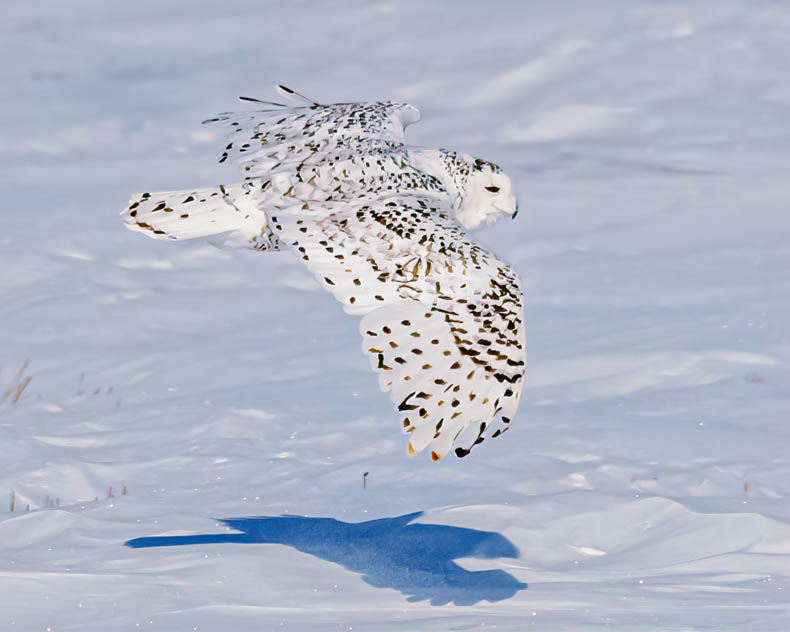 Snowy Owl, passing by me as it hunts along the frozen Manitoba Prairie
Snowy Owl, passing by me as it hunts along the frozen Manitoba Prairie
Today I will introduce you to some of the owls that live in Manitoba year round, which are the Eastern Screech-Owl (Megascops asio), the Great Horned Owl (Bubo virginianus), the Snowy Owl (Bubo scandiacus), the Northern Hawk Owl (Surnia ulula), the Barred Owl (Strix varia), the Great Gray Owl (Strix nebulosa), the Boreal Owl (Aegolius funereus) and the Nothern Saw-Whet Owl (Aegolius acadicus). Of these eight Owls, I have had the good fortune to find, spend time observing and photographing six of these in the wild. The six owls I have seen in nature in Manitoba are the Eastern Screech Owl, the Great Horned Owl, the Snowy Owl, the Northern Hawk Owl, the Barred Owl and the Great Gray Owl.
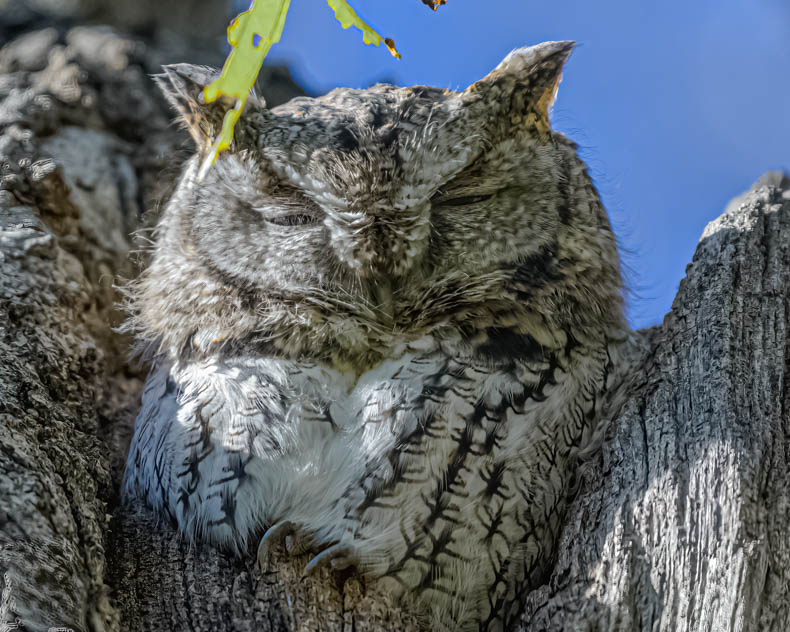
Sleepy Eastern Screech Owl watching me from above.
The Eastern Screech-Owl can be found year round in Southern Manitoba, and one of a few that resides among humans, nesting in hollows of old trees that are found growing in parks, cemeteries, along river banks and in the back of people’s yards. Because they readily habituate to people, Eastern Screech-Owls sometimes roost and nest in human-made cavities such as bird boxes. They are often the most common avian predator in wooded suburban and urban habitats. These owls are mostly Nocturnal, meaning they hunt at night, and with excellent low light vision are able to see and capture their prey from their perches in the upper canopy of the trees.
Eastern Screech-Owls are socially and genetically monogamous. Nesting occurs between March and June. Females incubate three to five eggs for thirty days, feed nestlings for nearly as long, and then tend to the fledglings for eight to ten weeks. Prey include terrestrial and aquatic invertebrates and vertebrates taken opportunistically; their diet is the most varied of any North American owl. The monotonic trill and whinny call of Eastern Screech-Owls are their most frequent vocalizations, particularly in the weeks before nesting begins when pairs are forming and during late summer and early fall when young are dispersing and seeking their own territories, but their vocal repertoire also includes various barks, hoots, squeals, and screeches—hence the common name.
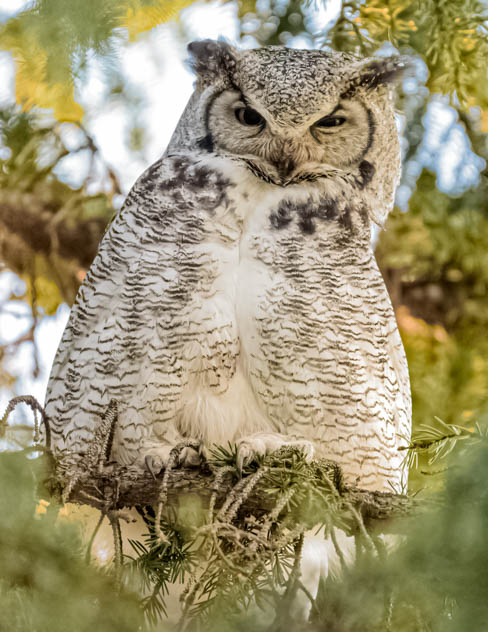
Great Horned Owl Watching me Closely
The Great Horned Owl - large, powerful, and long-lived - is adapted by its anatomy, physiology, and behavior to survive in any climate but arctic-alpine regions. Equally at home in desert, grassland, suburban, and forest habitats, north to the tree line, it has a diverse prey base and the most extensive range with the most variation in nesting sites of any American owl. This is a large, powerful owl, that when threatened can be very aggressive, particularly when protecting eggs in a nest or young owlets that have hatched and are learning to survive, while still growing and being cared for by both parents. With one of the most powerful talon force of any North American owl, the Great Horned owl can apply five hundred pounds of pressure per square inch, which amounts to 28.7 pounds of gripping force (equal to the bite of a German Shephard Dog). You don’t want to be the recipient of those talons if you have gotten too close to one of their young or a nest in a tree (you would be surprised at how stupid some people can be when trying to get that so-called perfect photo), as you could easily lose an eye, or worse.
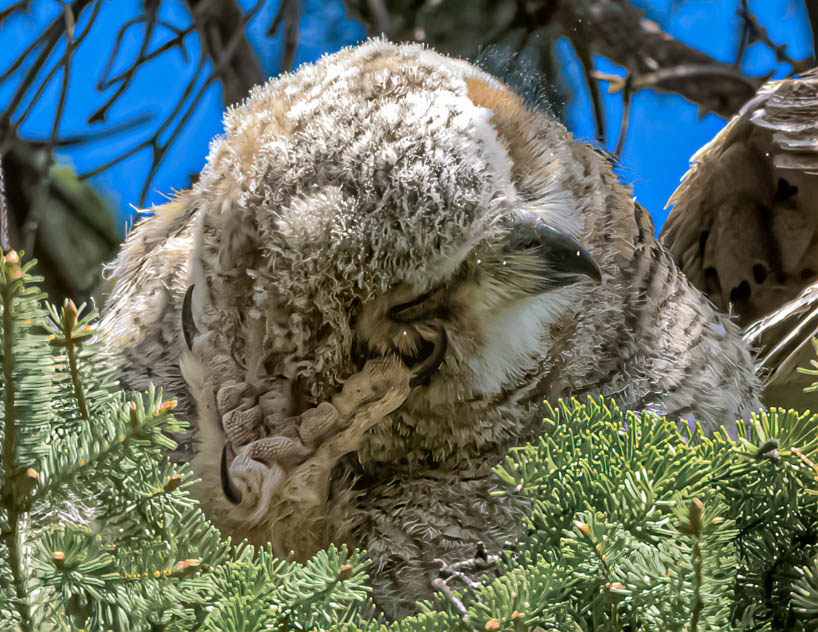
Great Horned Owlet Scratching an Itch
In this photo of a young Great Horned Owlet, you can see the length of the talons, which are approximately half an inch long and already very powerful. The diameter of the talons on the owls claw is four to eight inches, with rough pads on the bottom of it’s feet that help to grip prey and other objects. Its large eyes are equipped with many rods for night vision and pupils that open widely in the dark. Although its eyes do not move, flexibility in the atlanto-occipital joint enables this owl to swivel its head more than one hundred eighty degrees, and to look in any direction.
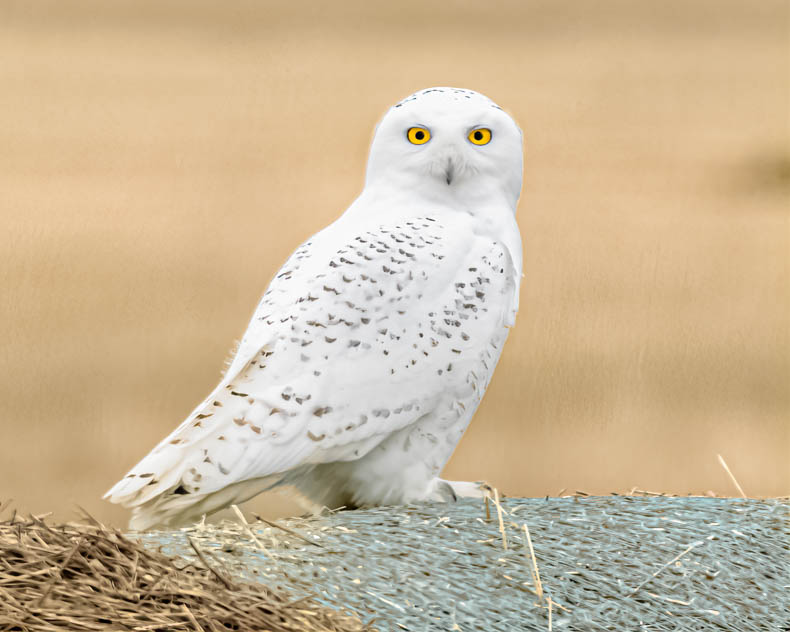
Snowy Owl Perched on a Hay Bale, Keeping a Close Eye on Me
Another owl that has been known to be fairly aggressive if threatened is the Snowy Owl, also known as the Arctic Owl or White Owl, which nests on Arctic tundra habitats throughout its northern circumpolar breeding range - often adjacent to coastal Arctic seas. This is one of the largest owls in the world, and has the most northerly breeding and wintering distribution of any owl species. During explosion years, where mostly younger owls are forced to fly south to find food, these beauties can be found throughout all of Southern Manitoba, but prefer the open Prairies which are similar to the tundra. I have seldom seen a Snowy Owl in a tree, but on occasion this has happened and is always a pleasant surprise for me.
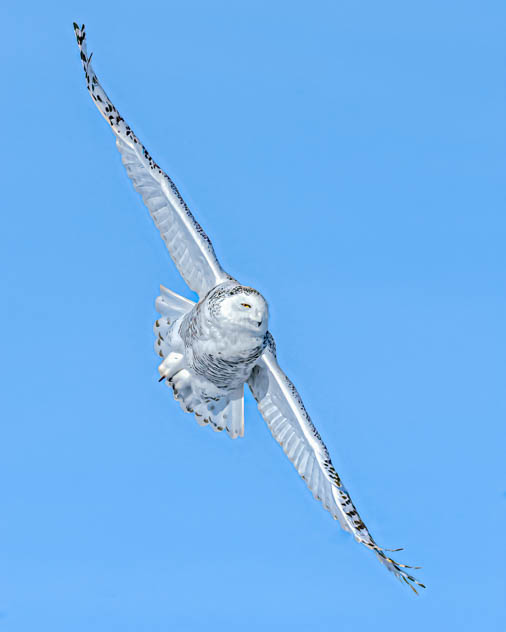
Snowy Owl in Flight, just after Taking Off from a Hydro Pole
The plumage is unmistakable in this species. Adult males are almost pure white, and adult females are white with brown/black barring. Females are distinctly larger than males. Young males resemble adult females, but have more spotting on their flight feathers; it may take many years for males to acquire their nearly pure white adult plumage. Females are believed to become somewhat whiter with age but they maintain distinct brown bars throughout their lives. It remains unknown at what age adult definitive basic plumage is reached for either sex, or when Snowy Owls breed for the first time.
One of the things we should always be careful about is identifying a Snowy Owl based on the common methods, because in some cases the males have remained darkly barred all their lives and the females have become almost pure white as they aged. So unless you are a professional who knows how to identify these beauties by sex just by sight alone, it is better to not call the Snowy Owl you have spotted and photographed a male or a female.
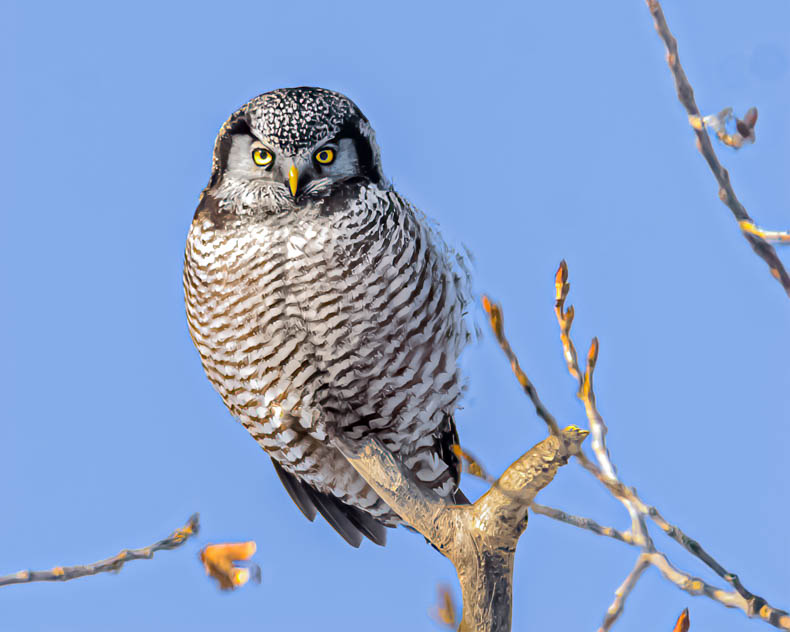
Northern Hawk Owl, Perched on the top of a nearby tree, and Keep an eye on me while it Hunts for Food
One of the least-studied birds of North America, the Northern Hawk Owl has a bold nature and seems to lack fear of humans, delighting birders, who often travel great distances to observe it. In Manitoba, it is one of the birds we see most often during the winter, while it comes out to the edge of the Boreal Forest to hunt for prey. Often when I see the Great Gray Owls hunting for food in the winter, I will also see the Northern Hawk Owl nearby. It is atypical in morphology and behavior compared to other Northern Hemisphere owls, resembling in many ways the Accipiter hawks—hence the name hawk owl. Primarily diurnal, this species usually perches atop prominent trees. When flying, it either glides low over the ground at high speed or flaps its pointed wings in deep, powerful, falcon-like strokes.
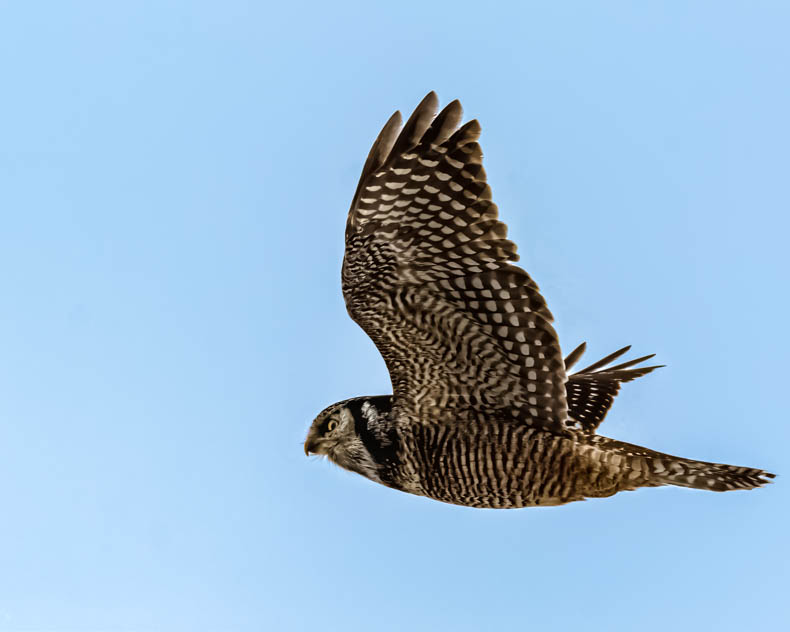
Northern Hawk Owl in Flight, but still keeping an eye on me as it passes by
Although this owl winters throughout its breeding range, it periodically “invades” southern Canada and the northern United States. The magnitude and extent of these winter irruptions are thought to correlate with high reproductive success followed by severe winter conditions and decreased prey availability. Early studies suggest that this owl eats primarily small rodents, but recent evidence indicates that grouse, ptarmigan, and hares comprise a greater proportion of their diet than previously thought. No less diurnal (diurnal means that it hunts during both daylight and at night) than the Snowy Owl or the Short-eared Owl, the Northern Hawk Owl will hunt in bright sunlight and also at night. At northern latitudes with continuous daylight in summer and darkness in winter, it hunts during all hours.
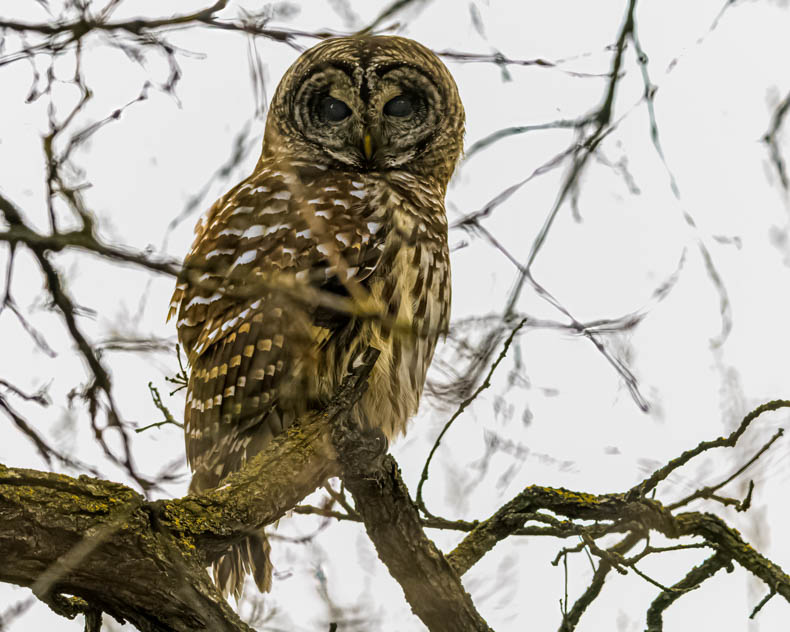
Barred Owl Watching me from Above
Barred owls are year-round residents of mixed, mature forests. Barred owls nest in cavities of trees measuring six to 12 metres high. They are found exclusively in mature forests, which feature an abundance of prey and large mature trees with nesting cavities. Barred Owls prey on small mammals, reptiles, amphibians and invertibrates. They have also been known to prey on birds as large as a Grouse and will also feed upon fish and crayfish they catch from streams and rivers. This photo of a Barred Owl, was my first sighting and photograph of one and although they are fairly common in Manitoba, they are not always easy to spot.
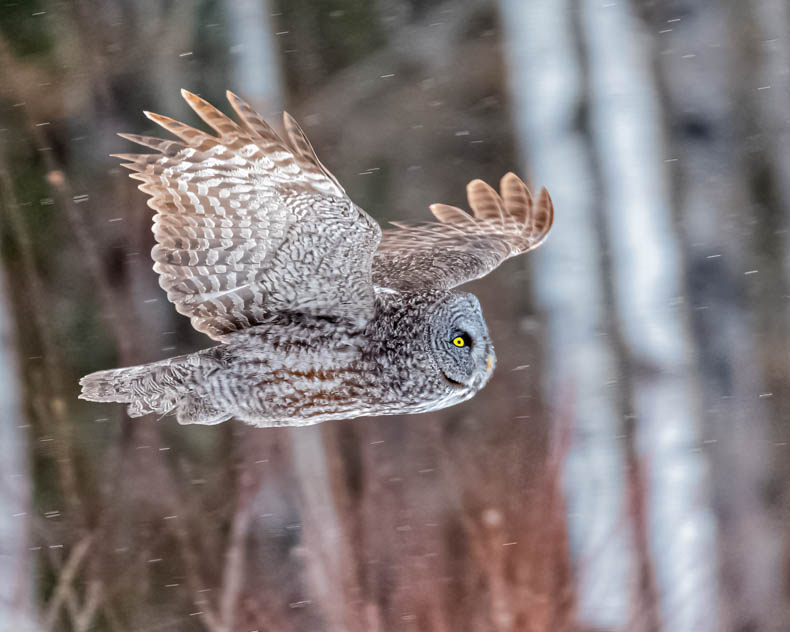
Great Gray Owl doing a Fly-by, while maneuvering through the trees of the Boreal Forest
The Great Gray Owl, Manitoba’s Provincial Bird and the largest Strix in North America, is the only member of its genus that breeds in both the Old and New Worlds. A rodent specialist, this owl favors areas near bogs, forest edge, montane meadows, and other openings. In some winters, when its prey are scarce, individuals from northern populations of this elusive raptor wander south to the northern U.S. and southern Canada, often in considerable numbers and always to the delight of birdwatchers. A single Great Gray Owl wintering on a farm in Massachusetts for two months in 1973 attracted at least three thousand birdwatchers. There have been a number of years in Manitoba, where we see Great Gray Owls in larger numbers than we have in other years, with many individual birders and photographers being able to see and photograph this majestic bird and share their photos to social media in far greater numbers than normal.
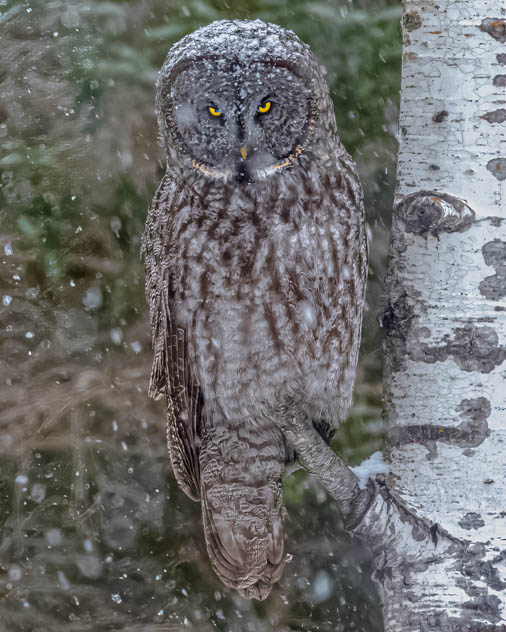
Snow Capped Great Gray Owl Hunting
Although it appears to be more massive than other owls of the northern forest (it is the largest owl in Manitoba by size, but not by weight), its actual body mass is at least 15% smaller than the more common Great Horned Owl (Bubo virginianus), with which it shares habitat. Thus its plumage makes up much of the bulk of the bird, allowing it to withstand the bitter cold of northern winters. In addition, the Great Gray Owl can accurately locate by ear its rodent prey under snow, plunging through the surface to grab the unsuspecting vole beneath. It has been reported to break through snow crust thick enough to support the weight of an eighty kilogram man.
So there you have it, a bit of information about a few of the Owls of Manitoba, and hopefully over the next few years I will be able to find and spend time observing them in their natural habitat and photograph each of the other Owls that make Manitoba their home.
I would like to add, that during these times of explosions of owls in the winter, those who normally would not know where to find most of what I call our more common Winter Owls (Snowy Owl, Great Gray Owl and Northern Hawk Owl) are able to go out in nature and observe them in person. This often draws many photographers out to try and get photos of these beauties to add to their collection of other birds that they have now found and share on social media. But it also draws photographers who are not as caring as some others and will go to any means to get the photo, and don’t care about the birds or the privacy of the homeowners who they will at times illegally block their driveways and enter private property, all for the sake of getting a photo, that they may be able to sell to a magazine or online stock photo site. Both the homeowners and the birds become stressed and in some cases accidents happen that cause owls to become injured or die, and turns homeowners sour against all photographers that drive by their homes or illegally walk on their property.
I would ask that everyone please be respectful of both the birds (and other wildlife you happen to see) and of the private property around you. Don’t chase after a bird that has taken flight from you, just so you can get that coveted photo, and always ask any homeowners permission before entering their private property, if that is something you feel you need to do. I personally try not to go on private property unless I either know the owner, or have prior permission to enter it. I mostly take my photos from the quiet of my vehicle, using it as a blind so as to not stress out the bird. And when I do approach on foot, I do so quietly and with the needs of the bird before my own needs, trying not to bump it from where it is perched. Winter is a difficult time of survival for all birds that reside in Manitoba year round, and it is up to each of us to give them the space they need in order to catch their prey in order to survive.
